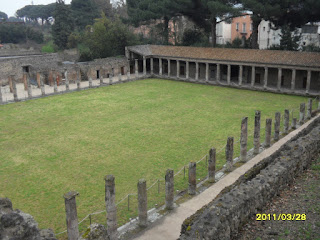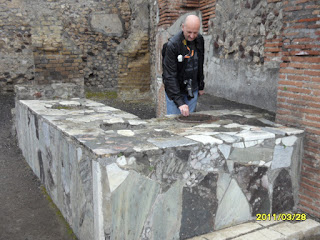We are planning to stay in Napoli again tonight so left all our luggage in the hotel and caught the approx one hour train to Pompeii. Cost was only 2.40euro each for a one way ticket but that seems cheap to me. We got the audio guides for 5eur each even though we had a book from Tam with all the same info but it is faster for me to listen than to read. Tickets were 11 euro each for the gate and we were off. The city of Pompeii is huge and we did not begin to cover it although I had thought I would get to most of it. There are so many streets and many are dead ends so we never did find the huge amphitheatre but we did come across two theares. One was the 'small theatre' for poetry reading, mime shows etc and sat 1300 people.
 |
| Small Theatre Seating |
 |
| Stage of Small Theatre |
The stage is beautiful multi-coloured marble and all the seats are intact but the external marble of the seats has long been removed - most likely in some church somewhere. The large theartre seats 5000 people and was used for plays, political rallies etc.
 |
| Seating in the Large Theatre |
There is a huge courtyard accessible from both theatres where folks would gather at intermission for drinks and socializing. These people were very civilized.
 |
| This area was covered and accessed from both theaters |
Pompeii began in the 7th centure BC but most of the best homes we saw were built in the 2nd century BC. I was surprised to find there were at least 89 'Thermaporiums', hot food sellers in town.
 |
| Rick serving up some Hot corn chowder from his Thermoporium |
These were not cafes, but places where you purchased hot food and took it home to eat. Fast food was obviously not invented by Christians. Many homes had a store in front and a private, family entrance to the house, next to the store.
 |
| This home had a bakery on the main floor. They ground the grain on these stones with the help of a mule. The kitchen was next to the mill room. The stable was on the opposite of the mill room. |
Most homes were large, at least the size of my house and larger, with 3 bedrooms, kitchen, latrine, private garden and the main room always had a water fountain and sometimes pillars.
 |
| A typical living room or foyer. Always a water feature or fountain. |
All walls appear to be painted frescoe style. Some had paintings of gods, or hunting scenes and some had architectural paintings of pillars and marble-like panels.
The entire city is made of brick and concrete and would have had marble panels on the outside.
 |
| A typical street in Pompeii. Raised sidewalks on both sides of the street. Their water system was not as sophisticated as Ephesus and they brought water in through lead pipes but the dirty water sometimes returned to the sea through the streets after heavy rains. |
 |
| A typical mosaic floor. Most floors appear to be in black and white 1/4" tiles. |
Excavation of Pompeii began in the late 1500's and has been going on ever since. There is still much to uncover but it won't be completed in this lifetime.
I could go on and on but best just to refer to the book or the internet for pictures and details.
When we got back to Napoli, we again headed for Da Michelle and lo and behold it was open and there was no lineup. We just sat down and chose between the only two kinds of pizza on the menu. Maguerita or Marinara. You could have the normal size or another size. Ours was pretty big but as it was the cheapest, the other size must of been bigger. Pizza cost 4eur each and drinks were 1.50 eur. Rick had a can of coke and I had a litre of sparkling mineral water - same price. The pizza was pretty darn good but the crust was a little thicker than L'Archetto which I actually prefer. The pizza is definitely not worth having to walk through Naples for, although I think most of the garbage has been picked up today so maybe they just put it out the day before. Traffic is a nightmare as well.
















No comments:
Post a Comment